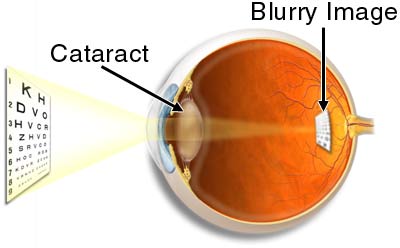Cataracts

A cataract is a clouding of the eye's natural lens, which lies behind
the iris and the pupil. The lens is mostly made of water and protein.
The protein is arranged in a precise way that keeps the lens clear and
lets light pass through it. But as we age, some of the protein may clump
together and start to cloud a small area of the lens. This is a
cataract, and over time, it may grow larger and cloud more of the lens,
making it harder to see.
Cataract signs and symptoms
An
early cataract will have little effect on your vision. A cataract may
make light from the sun or a lamp seem too bright or glaring. Or you may
notice when you drive at night that the oncoming headlights cause more
glare than before.
What causes a cataract?
No one knows
for sure why the eye's lens changes as we age, forming cataracts. Some
studies suggest people with diabetes are at risk for developing a
cataract. The same goes for users of steroids. Some people are born with
cataracts while other people develop them subsequently to trauma to the
eye.
Cataract treatment
When symptoms begin to appear,
you may be able to improve your vision for a while using new glasses,
strong bifocals, magnification, appropriate lighting or other visual
aids. Think about surgery when your cataracts have progressed enough to
seriously impair your vision and affect your daily life. Many people
consider poor vision an inevitable fact of aging, but cataract surgery
is a simple, relatively painless procedure to regain vision. During
surgery, the surgeon will remove your clouded lens, and in most cases
replace it with a clear, plastic intraocular lens.
|